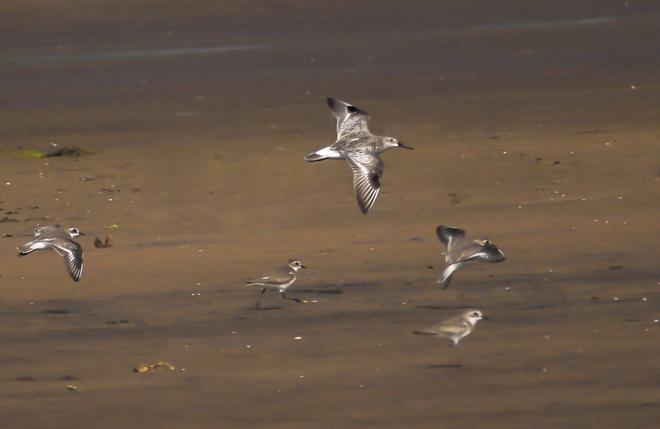Context
-
Three new species recorded from Visakhapatnam at the recently-concluded Asian Waterbird Census.
-
The census was conducted in a few well known birding spots like Telineelapuram in Srikakulam district and the surrounding ponds, the Naupada swamps a few kilometres away from Telineelapuram, Kondakarla Ava in Visakhapatnam which is one of the largest freshwater lakes in AP, and Thatipudi reservoir in Vizianagaram district.
Key Findings
- The season’s new records — Great Knot and Sanderling. These two bird species were recorded for the first time from Visakhapatnam.

Photo Credit: Prem Swaroop Kolluru - The members of the Vizag Birdwatchers’ Society (VBS) also spotted two broad billed sandpipers in the waters.
- Great knot is listed as an ‘endangered’ species by the IUCN and is a small wader.
- It is the largest of the calidrid species and has its breeding habitat in Tundra in northeast Siberia.
- They are mainly migratory birds visiting the coasts in southern Asia.
- Earlier they were recorded in Kakinada in good numbers but never in this part of Andhra Pradesh.
- Sanderling, a small wading bird, is a circumpolar Arctic breeder.
- It is a long-distance migrant, migrating in winter to South America, South Europe, Africa, and Australia.
- Sanderling was earlier recorded in a few numbers from Kakinada and Srikakulam.
Other Key Findings
- The Asian emerald dove, which is a usual habitant of hilly forested regions, was spotted amidst the Vizag port area. This was a rare sighting during this AWC. There are previous records of this species from Maredumalli and Paderu in Visakhapatnam.
- Some important migratory waders that were observed in this stretch of coast and inland water bodies include black-tailed godwit, wood sandpiper, marsh sandpiper, common sandpiper, green sandpiper, curlew sandpiper, common and spotted redshank, Pacific golden plover, common greenshank, ruff, little ringed plover, kentish plover, little stint and Temminck’s stint.
- The birders also found migratory ducks such as cotton pygmy goose, common pochard, red-crested pochard, ruddy shelduck, green winged teal, gadwall, northern pintail, northern shoveler, Eurasian wigeon and tufted duck.
- The eastern marsh harrier, short-toed snake eagle, osprey, white-bellied sea eagle, oriental honey buzzard are important raptors that are spotted here.
- The AWC recorded many species that are recognised as ‘near threatened’ by the IUCN Red list.
- These are the black- headed iIbis, oriental darter, alexandrine parakeet, painted stork and curlew sandpiper.
- The common pochard and river tern are ‘vulnerable’ species.
Back to Basics
About Asian Waterbird Census (AWC)
- This is a citizen science programme called the Asian Waterbird Census (AWC).
- The AWC is an integral part of the global waterbird monitoring programme, the International Waterbird Census (IWC), coordinated by Wetlands International South Asia and Bombay Natural History Society in India.
- The Asian Waterbird Census (AWC) takes place every January.
- The AWC was initiated in 1987 in the Indian subcontinent and since has grown rapidly to cover major region of Asia, from Afghanistan eastwards to Japan, Southeast Asia and Australasia.
- The census, thus covers the entire East Asian – Australasian Flyway and a large part of the Central Asian Flyway.
Source: TH
Visit Abhiyan PEDIA (One of the Most Followed / Recommended) for UPSC Revisions: Click Here
IAS Abhiyan is now on Telegram: Click on the Below link to Join our Channels to stay Updated
IAS Abhiyan Official: Click Here to Join
For UPSC Mains Value Edition (Facts, Quotes, Best Practices, Case Studies): Click Here to Join
